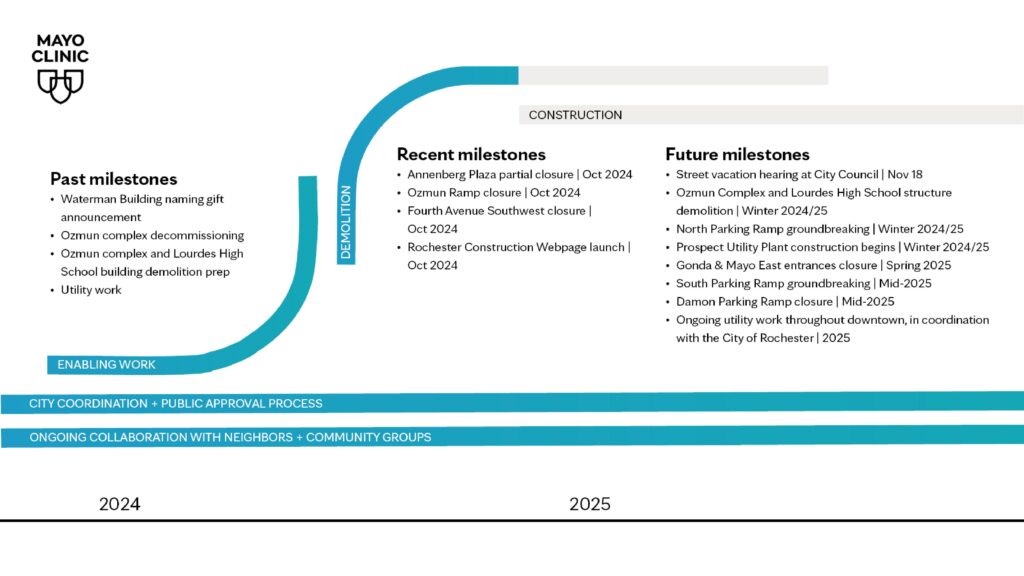One year of Bold. Forward. Unbound
(ABC 6 News) – It’s been a year since Mayo Clinic unveiled its’ Bold. Forward. Unbound. plan to reshape downtown Rochester, and to celebrate Mayo leaders looked back at what they’ve done over the last year and where they’re set to go next.
Much of Mayo Clinic’s efforts in 2024 was preparing for the long haul of rebuilding its downtown Rochester campus.
Now, though, the real work is already beginning.
As the project takes shape, residents can already see changes taking place downtown – with more on the way.

The final demolition for both the Ozmun complex and former Lourdes High School building is likely to take place in the coming months.
At the same time, the clinic will break ground on new ramps to help parking troubles, one on the north side for patients and one on the south side for employees.
The latter is actually coming much sooner than expected.
“This is a parking structure whose timeline was accelerated so it can be open early for staff to use during the construction period,” said Chair for Mayo’s Department of Facilities, Doug Holtan.
Mayo also plans to close the Damon Parking Ramp some time next year to make way for the new Waterman building which will connect to the main Gonda building and the new Ozmun building.
“We are a multi-disciplinary practice taking care of the most serious and complex patients,” said Dr. Katherine Arendt, Bold. Forward. Unbound. in Rochester Physician Lead. “We do that by surrounding the patient with all the different team members. Our connectedness across those buildings is incredibly important to that mission.”
Of course, new construction means accessing certain areas of downtown and the clinic may get more difficult.
One way Mayo is trying to combat that is through a new webpage, providing updates on the status of construction plans, like the closure of Third Avenue SW for November 16.
The site will also direct patients to the easiest parking, drop off, or valet options available depending on which building they need to get to for appointments.
Then there’s pedestrian access.
Mayo’s construction goals are likely to take over significant portions of downtown, especially as they work to update utilities and subway spaces, and will cut off both Third and Fourth Avenues, which contain the only north-south running bike lanes in downtown.
Mayo, however, says it’s trying to keep a pedestrian focus both during and after construction.
“One of the ways we’re doing that is through ensuring there is access through our building at Fourth Avenue, so that there does remain that pedestrian connectivity through there,” said Erin Sexton, senior director for external relations.
That access will look similar to the access between Broadway and Peace Plaza through the Galleria, open during business hours for anyone to pass through, even if they’re not explicitly visiting Mayo Clinic.
Plus, Mayo is also looking to replace the bike lanes its’ new buildings are be placed on top of.
“Right now, the lanes are going in front of the very, very busy Gonda building, so we’re looking at new alternatives with the city that will be even better than what it is today,” said Holtan.
Overall, Mayo leaders say they’re trying to learn from past projects, like the “Heart of the City” which redesigned Peace Plaza, to lessen the impact of its’ construction on the surrounding area.
“As we get in to sort of Second Avenue and moving the Gonda east entrance project, we’re going to have to be really thoughtful about how we maintain access into downtown,” said Sexton.
Mayo Clinic has a hearing scheduled to discuss the vacation of Third and Fourth Avenue at City Hall on November 18.